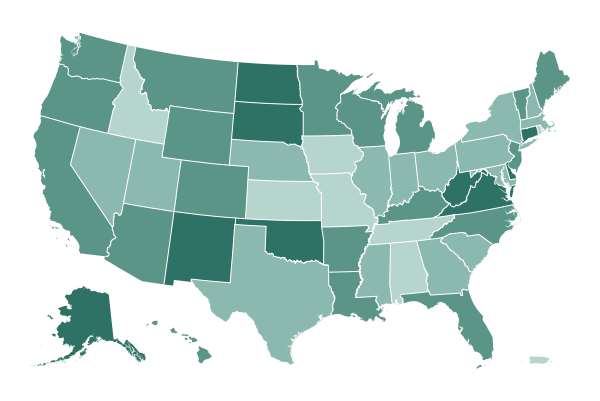The nation’s largest public school system will take another step toward a full reopening later this month by welcoming middle school students back into classrooms that have been shuttered since November.
About 62,000 of New York City’s middle school students who opted for in-person learning last year will be able to return to classrooms for at least part of the week starting Feb. 25. The city still does not have a plan to reopen its high schools.
Reopening schools has become one of the most fraught political issues in cities across the country, and New York City has been no exception. Mayor Bill de Blasio battled with the teachers’ union for months before eventually settling on a reopening plan that included stringent safety measures. In Chicago, Mayor Lori Lightfoot announced a tentative agreement with the teachers’ union on reopening Sunday evening, following weeks of intensive debate.
The return of middle school students means that by the end of February, about 250,000 of New York City’s roughly 1 million public school students will be back in school buildings. Richard A. Carranza, the city’s schools chancellor, said Monday that about half of the 471 middle schools reopening will be able to accommodate most children five days a week, and that at least some of the other schools should be able to move toward that goal in the coming months.
Despite many schools opening for full-time in-person learning, many elementary and middle school students will still be rotating in and out of classrooms and online classes every few days to allow for social distancing.
“Our schools have been remarkably safe, in fact the safest places in New York City,” Mr. de Blasio said during a news conference on Monday. “That’s why we know its time to bring back our middle-grade kids now.”
He added, “I know our children are ready, our parents are ready.”
Still, the vast majority of city students — roughly 70 percent — have opted out of in-person classes altogether, and decided to learn from home through the rest of the school year. A disproportionate number of white students have returned to classrooms, while many Black, Latino and Asian-American families have chosen remote learning. Many Black families in particular have said they are distrustful of school districts, and do not believe that their children will be safe in classrooms.
When Mr. de Blasio opened schools for all grade levels in October, New York’s became the first major school system in the country to reopen, if only partially. But the mayor closed the entire school system only about six weeks later, as virus cases surged. Mr. de Blasio then reopened classrooms for elementary school students and children with advanced disabilities in December.
The city is not changing the safety measures it negotiated with the teachers’ union last year. Those measures include random weekly testing of students and staff in schools and requiring school buildings to close temporarily if at least two unrelated positive cases are detected.
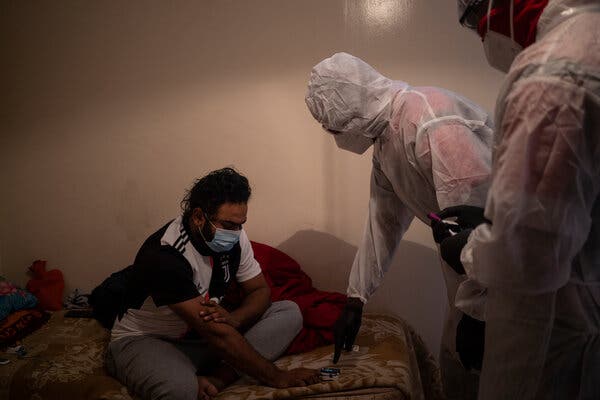
South Africa has halted use of the AstraZeneca-Oxford coronavirus vaccine after evidence emerged that the vaccine did not protect clinical-trial participants from mild or moderate illness caused by the more contagious virus variant that was first seen in the country.
The findings were a devastating blow to the country’s efforts to combat the pandemic.
Scientists in South Africa said on Sunday that a similar problem held among people who had been infected by earlier versions of the coronavirus: The immunity they acquired naturally did not appear to protect them from mild or moderate cases when reinfected by the variant, known as B.1.351.
The developments, coming nearly a week after a million doses of the AstraZeneca-Oxford vaccine arrived in South Africa, were an enormous setback for the country, where more than 46,000 people are known to have died from the virus. And they were another sign of the dangers posed by new mutations. The B.1.351 variant has already spread to at least 32 countries, including the United States.
The low number of cases evaluated as part of the studies outlined by South African scientists on Sunday made it difficult to pinpoint the precise effect of the variant. And it was not clear whether the AstraZeneca-Oxford vaccine protected against severe disease from the B.1.351 variant.
The clinical trial participants who were evaluated were relatively young and unlikely to become severely ill, making it impossible for the scientists to determine whether the variant interfered with the AstraZeneca-Oxford vaccine’s ability to protect against severe Covid-19, hospitalizations or deaths.
However, based on the immune responses detected in blood samples from people who were given the vaccine, the scientists said they believed that the vaccine could yet protect against more severe cases.
If further studies show that it does, South African health officials said on Sunday that they would consider resuming use of the AstraZeneca-Oxford vaccine.
Even so, the fact that it showed minimal efficacy in preventing mild and moderate cases of the new variant added to the mounting evidence that B.1.351 makes current vaccines less effective. These research findings have not been published in a scientific journal.
Pfizer and Moderna have both said that preliminary laboratory studies indicate that their vaccines, while still protective, are less effective against B.1.351. Novavax and Johnson & Johnson have also sequenced test samples from their clinical trial participants in South Africa, where the variant caused the vast majority of cases — and both reported lower efficacy there than in the United States.
“These results are very much a reality check,” Shabir Madhi, a virologist at University of the Witwatersrand who ran the AstraZeneca-Oxford vaccine trial in South Africa, said of the findings released on Sunday.
The pause in the country’s rollout of the AstraZeneca-Oxford vaccine means that the first shipments will now be put in warehouses. Instead, South African health officials said they would inoculate health workers in the coming weeks with the Johnson & Johnson vaccine, which has strong efficacy in preventing severe cases and hospitalizations caused by the new variant.
Johnson & Johnson has applied for an emergency use authorization in South Africa. But health officials there indicated that even before it is authorized, some health workers could be given the vaccine as part of an ongoing trial.
In the AstraZeneca-Oxford trial in South Africa, roughly 2,000 participants were given either two doses of the vaccine or placebo shots.
There was virtually no difference in the numbers of people in the vaccine and placebo groups who were infected with B.1.351, suggesting that the vaccine did little to protect against the new variant. Nineteen of the 748 people in the group that was given the vaccine were infected with the new variant, compared with 20 of 714 people in the group that was given a placebo.
That equates to a vaccine efficacy of 10 percent, though the scientists did not have enough statistical confidence to know for sure whether that figure would hold among more people.
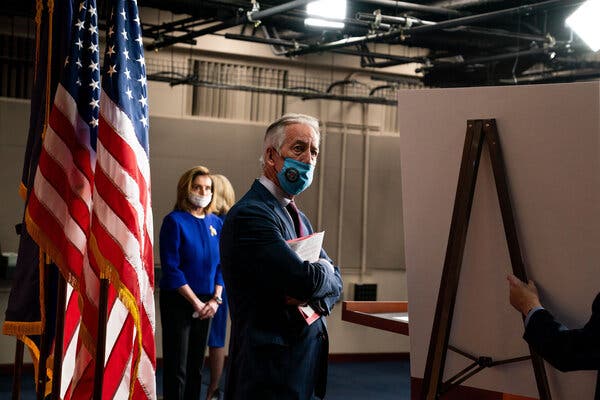
Top House Democrats are preparing to unveil legislation that would send up to $3,600 per child to millions of Americans, as lawmakers aim to change the tax code to target child poverty rates as part of President Biden’s sweeping $1.9 trillion stimulus package.
The proposal would expand the child tax credit to provide $3,600 per child younger than 6 and $3,000 per child up to 17 over the course of a year, phasing out the payments for Americans who make more than $75,000 and couples who make more than $150,000. The draft 22-page provision, reported earlier by The Washington Post and obtained by The New York Times, is expected to be formally introduced on Monday as lawmakers race to fill out the contours of Mr. Biden’s stimulus plan.
“The pandemic is driving families deeper and deeper into poverty, and it’s devastating,” said Representative Richard E. Neal of Massachusetts, the chairman of the Ways and Means Committee and one of the champions of the provision. “This money is going to be the difference in a roof over someone’s head or food on their table. This is how the tax code is supposed to work for those who need it most.”
The credits would be split into monthly payments from the Internal Revenue Service beginning in July, based on a person’s or family’s income in 2020. Although the proposed credit is for only a year, some Democrats said they would fight to make it permanent, a move that could reshape efforts to fight child poverty in America.
The one-year credit appears likely to garner enough support to be included in the stimulus package, but it will also have to clear a series of tough parliamentary hurdles because of the procedural maneuvers Democrats are using to muscle the stimulus package through, potentially without Republican support.
The House Democratic leadership is aiming to have the stimulus legislation approved on the chamber floor by the end of the month, and Congress moved last week to fast-track Mr. Biden’s stimulus plan even as details of the legislation are still being worked out. Buoyed by support from Democrats in both chambers and a lackluster January jobs report, Mr. Biden has warned that he plans to move ahead with his plan regardless of whether Republicans support it.
Chris Cameron and Jim Tankersley contributed reporting.

Restaurants in New York City can again begin serving customers indoors on Friday, two days earlier than previously planned, Gov. Andrew M. Cuomo announced at a news conference on Monday.
The city’s restaurants, which have been prevented from conducting business indoors since December, were originally slated to resume indoor dining on Sunday, which is also Valentine’s Day.
The holiday is often a busy night for the city’s restaurant business, but Sundays are typically slower in the industry. Many restaurant owners asked the governor to consider allowing indoor dining to begin earlier so they could recoup lost revenue with weekend dining crowds.
“They have made the point that they would like to open a couple of days earlier so they can be ready for Valentine’s Day,” Mr. Cuomo said.
After reviewing the latest virus data, the state had concluded that was “a reasonable request,” he added.
Andrew Rigie, the executive director of the NYC Hospitality Alliance, an industry group, applauded Mr. Cuomo’s decision.
“This will allow restaurants to generate much needed revenue from the Valentine’s Day weekend business, much of which they would have lost because the holiday falls on a Sunday this year,” he said in a statement.
The seven-day average of new cases, as well as hospitalizations and the positive test rate, has been declining in New York City in recent weeks after a steady rise in December and early January. But all three metrics remained higher, as of Thursday, than they were in December when he initiated the indoor dining ban in the city.
Restaurants will be subject to significant limits in their dining rooms. They will be allowed to operate at only 25 percent capacity indoors, and restrictions that were in place when indoor dining was first allowed in the fall — including temperature checks and mandatory distance between tables — will remain in place.
Restaurant workers are also eligible to receive a coronavirus vaccine in New York City, after Mr. Cuomo last week loosened guidelines to allow them to be inoculated before the return of indoor dining.
Outside the city, restaurants in New York State are permitted to operate at half capacity. Many restaurant owners and industry groups, including Mr. Rigie’s, have called for an end to the discrepancy, which Mr. Cuomo has framed as necessary because of the city’s density.
John Keefe contributed reporting.
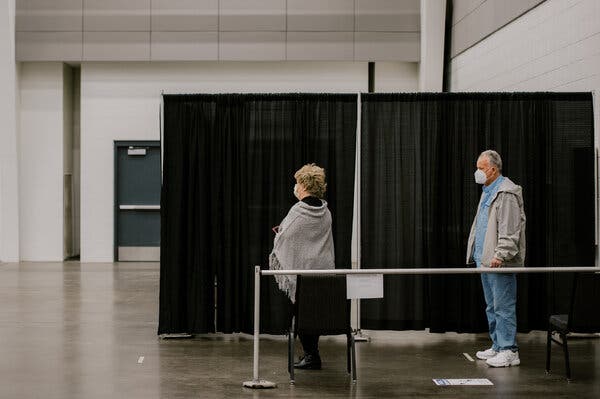
For a vast majority of Americans, a coronavirus vaccine is like sleep for a new parent: It’s all you can think about, even if you have no idea when you will get it.
People are scrolling through perpetually crashing websites at 3 a.m., or driving 150 miles each way in the snow. Others are lining up at grocery stores for hours on end, hoping to snag a leftover shot, or racing to hospitals amid rumors of extra doses.
Many more are tossing in bed in the dark, praying that tomorrow will be their mother’s lucky day.
A small portion — about 11 percent — have received one or two shots of the vaccine, leaving the nation in a medical and cultural interregnum. Some of those with only one shot are in a precarious limbo, in states snarled over second-dose distribution.
Byzantine rules setting up tiers of the eligible mean most will be holding their collective breath for months, as another set moves gingerly toward the restoration of their lives on the other side of the divide.
Debates over masks, indoor eating, testing availability and school reopenings all now center on a single axis: the lagging rollout of the vaccine.
It is the alchemy of “unrelenting waves of exhaustion, fear, hope, uncertainty and pandemic fatigue,” said Lindsey Leininger, a health policy researcher and clinical professor at the Tuck School of Business at Dartmouth College in Hanover, N.H. “I stay focused on the lotus mud metaphor and think about how gosh-darned beautiful we are all going to be when we come out the other side.”
The United States recorded at least 87,000 new cases on Sunday, according to a New York Times database. Although the number of reported cases is usually lowest on Sundays, it was the first time since early November that the country had fewer than 100,000 new cases on a single day.
Still, although cases and hospitalizations continue to decline, and as the pace of vaccinations picks up, some Americans — including those now vaccinated and ostensibly protected — are approaching the spring and summer with trepidation. The divide is still quite wide between the haves and the have-nots, and many fear that even a vaccinated nation and world will not restore a sense of safety or security.
Dr. Anthony S. Fauci, the nation’s top infectious disease expert, discussed the vaccine supply during an interview broadcast on NBC on Sunday.
“I can tell you that things are going to get better, as we get from February into March, into April, because the number of vaccine doses that will be available will increase substantially,” he said on “Meet the Press.”
Dr. Fauci has also said that about 75 percent of the population would need to acquire resistance to the coronavirus, either through infection or vaccination, in order to achieve herd immunity.
President Biden, in an interview broadcast on CBS on Sunday, stressed that achieving herd immunity by the summer would be “very difficult.”
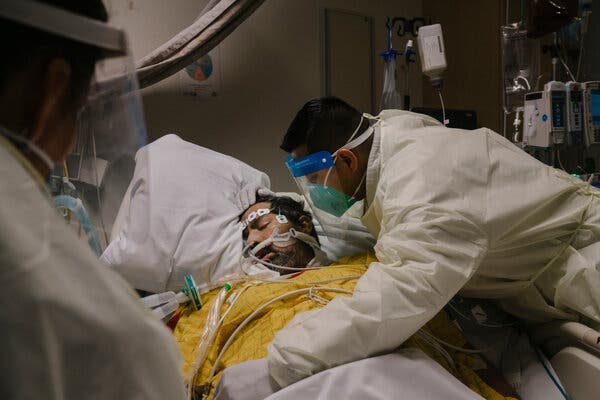
Over the New Year’s holiday, the grown children of two immigrant families called 911 to report that their fathers were having difficulty breathing. The men, born in Mexico and living three miles from each other in the United States, both had diabetes and high blood pressure. They both worked low-wage, essential jobs — one a minibus driver, the other a cook. And they both hadn’t realized how sick they were.
Three weeks later, the men — Emilio Virgen, 63, and Gabriel Flores, 50 — both died from Covid-19. Their stories were hauntingly familiar at Martin Luther King Jr. Community Hospital in Los Angeles, by size the hardest-hit hospital in the hardest-hit county in California, the state now leading the nation in cases and on the brink of surpassing New York with the highest death toll.
In the intensive care unit on Jan. 21, Mr. Virgen became No. 207 on the hospital’s list of Covid-19 fatalities; Mr. Flores, just down the hall, became No. 208.
The New York Times spent more than a week inside the hospital, during a period when nearly a quarter of all Covid-19 patients there were dying, despite advances in knowledge of the disease. It was an outcome that approached that of some New York hospitals last spring, when the city was the epicenter of the pandemic.
That rise coincided with a surge of cases in Southern California, a doubling of the mortality rate in Los Angeles hospitals over all and the spread of a new local strain that may be more transmissible than the more prevalent one.
Eight of 10 people who died at M.L.K. hospital were Hispanic, a group with the highest Covid-19 death rates in Los Angeles County, followed by Black residents. County data also showed that the most impoverished Los Angeles residents, many of them around the hospital in South Los Angeles, were dying of the disease at four times the rate of the wealthiest.
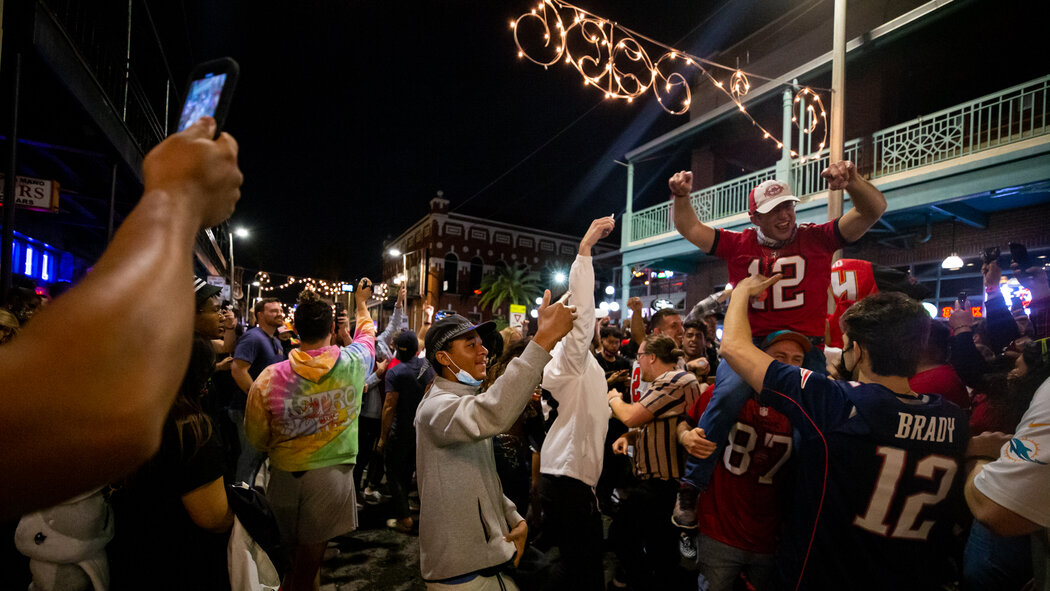
Shortly after the Tampa Bay Buccaneers crushed the Kansas City Chiefs in Sunday’s Super Bowl, fans took to the streets of Tampa to celebrate, and few, it appeared from videos of the crowds, were wearing masks, cementing concerns that the event would help spread the coronavirus.
In Ybor City, a part of Tampa known for its nightlife, a sea of people partied late into the night. It was not immediately clear whether any efforts had been made to disperse the crowd. A television reporter characterized the scene as “one massive dance floor.”
The scene of thousands of fans tightly packed into the city’s streets and outside Raymond James Stadium represented an alternate universe from the steady warnings by the nation’s top health officials about the risks of the Super Bowl becoming a super spreader event. It also came amid growing concerns that coronavirus variants have become more transmissible.
Inside the stadium, the home field of the Buccaneers that typically holds about 66,000 people, capacity had been limited to 22,000 spectators. The empty seats were filled with cardboard cutouts of fans who could not attend the game but paid $100 to have their photographs present.
Outside the stadium, there appeared to be far less of an emphasis on social distancing and wearing masks. Maskless fans in jerseys tailgated, waving Buccaneers flags and listening to music.
After the game, which Tampa won 31-9 over the Chiefs, last year’s champions, a group of fans surrounded a Kansas City team bus. Many people in that crowd did not appear to wearing masks. Officers on motorcycles cleared the crowd for the bus to be on its way.
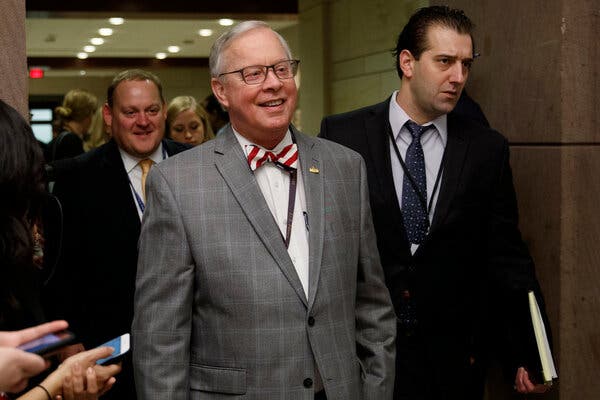
Representative Ron Wright, Republican of Texas, died on Sunday after battling Covid-19 in the hospital, his office said on Monday. He was 67.
Mr. Wright announced on Jan. 21 that he had tested positive for the coronavirus after coming into contact earlier in the month with someone who had the virus. In the statement about Mr. Wright’s death, his office said that he and his wife, Susan, had both been hospitalized in Dallas for the past two weeks.
The statement did not confirm whether the virus caused the death of Mr. Wright, who had also been undergoing treatment for cancer.
He is the first seated member of Congress to die after battling the virus. Luke Letlow, a Louisiana Republican elected in November, died a few days before he was scheduled to be sworn in.
“Congressman Wright will be remembered as a constitutional conservative,” the congressman’s office said in a statement. “He was a statesman, not an ideologue.”
“As friends, family, and many of his constituents will know, Ron maintained his quick wit and optimism until the very end,” the statement continued. “Despite years of painful, sometimes debilitating treatment for cancer, Ron never lacked the desire to get up and go to work, to motivate those around him, or to offer fatherly advice.”
Mr. Wright, a sixth-generation resident of Tarrant County, has represented Texas’ sixth congressional district since 2018. A former city council member, he was a member of the conservative House Freedom Caucus.
Representative Joaquin Castro, Democrat of Texas, said on Twitter that Mr. Wright “was a gentleman who cared deeply about public service.”
Saddened to lose a Texas colleague to COVID-19. I served with Ron on the Education and Labor Committee, and he was a gentleman who cared deeply about public service. My condolences to his family and friends. https://t.co/MFRrdPczID
— Joaquin Castro (@JoaquinCastrotx) February 8, 2021
Representative Kevin McCarthy of California, the minority leader, said on Monday that Mr. Wright was a colleague who “led with principle, integrity, and thoughtfulness” and “emulated the very best of America.”

In the race to vaccinate Americans against Covid-19, most states and counties are struggling to move fast enough to meet the immense demand. In one rural county in northeast Georgia, though, a clinic has been punished for getting on with the job too fast.
Georgia health officials suspended the Medical Center of Elberton from the state’s vaccine program for six months for starting to vaccinate teachers before they officially became eligible under state guidelines.
The clinic says it thought it was doing the right thing. By the end of December, it had vaccinated everybody in the area who wanted a shot and who qualified in the first eligible group, known as 1A — frontline health care workers and the residents and staff of nursing homes. So it moved on to the next batch of eligible people, group 1B, which included essential workers like teachers.
On Dec. 30, though, the state switched things up, announcing that it was expanding eligibility to include everyone 65 and older and their caregivers, as well as law enforcement officers and firefighters. It called that huge new group 1A+, and made them eligible starting Jan. 11, pushing group 1B and the teachers farther back in line.
Too late. “We had already finished vaccinating teachers by the time 1A+ came out,” said Dr. Jonathan Poon, who works at the clinic, though the teachers had only received the first of the two required doses. “We got caught in this in-between zone between guidelines,” he said.
Dr. Poon said Elberton County’s small population of roughly 20,000 people allowed the clinic to get the first group done sooner than other parts of the state had done, and the clinic wanted to keep moving forward. But instead of drawing praise, that swift progress got the clinic into trouble.
The Georgia Department of Health called on Jan. 26 to ask whether the clinic had been vaccinating teachers. “Next thing we know, on Jan. 28, we had our vaccine privileges suspended,” Dr. Poon said.
The following week, he said, state workers came to the clinic and took away its vaccine supply, leaving the clinic with only enough to administer second shots to people who had already gotten their first doses there.
The health department said in a statement that the clinic was wrong to have vaccinated people beyond the current phase of eligibility, and that it would no longer receive shipments of vaccine from the state.
The clinic appealed the decision once and was turned down. It is awaiting a response to a second letter of appeal.
“We were trying to be part of the solution, to get our community vaccinated,” Dr. Poon said. “Obviously, it’s been completely stripped away. And it’s not because we were trying to be first — it’s just that we saw what was going to be the best opportunity to get this done efficiently, which I thought was the whole goal of the vaccine rollout.”

Randi Weingarten, the most powerful teachers’ union president in the United States, has a message: She wants to get students back in the nation’s classrooms.
She spends 15 hours per day on the phone, she says — with local labor leaders, mayors, the White House, the Centers for Disease Control and Prevention — trying to figure out how to reopen the three-quarters of school systems that remain fully or partly closed.
But with the pandemic approaching its first anniversary, and a new president — a union ally — vowing to reopen elementary and middle schools within his first 100 days, she faces a difficult truth: In the liberal cities and suburbs where schools are most likely to remain closed, teachers’ unions are the most powerful forces saying no, not yet.
Not before teacher vaccinations, they say, or upgraded school ventilation systems, or accommodations for educators with vulnerable relatives.
The Chicago union had ground reopening to a halt before reaching a tentative deal on Sunday with Mayor Lori Lightfoot, averting a strike and agreeing to return K-8 students to classrooms by early March. The Philadelphia local is threatening to refuse to enter school buildings this week.
And California unions have left that state’s Democratic governor, Gavin Newsom, so frustrated that in a recent meeting he lashed out, saying, “If everybody has to be vaccinated, we might as well just tell people the truth: There will be no in-person instruction in the state of California.”
That puts Ms. Weingarten, leader of the 1.7 million-member American Federation of Teachers, the nation’s second-largest teachers’ union and a close ally of President Biden, in a tight spot. Responsive to her 3,000 locals, which sometimes push her from the left, she is also sensitive to a situation so historic as to be difficult to comprehend: For 10 months, tens of millions of children have had no access to in-person public education.
Young children unable to learn productively via screens, low-income students without reliable home internet, those with disabilities and other vulnerable groups have been hit hardest from lack of access to the academics and social services only school buildings can provide.
“We have to get this done,” Ms. Weingarten said of resuming in-person education — something she thinks can be accomplished safely even before teachers are widely vaccinated, provided certain conditions are met, such as in-school virus testing.
Global Roundup
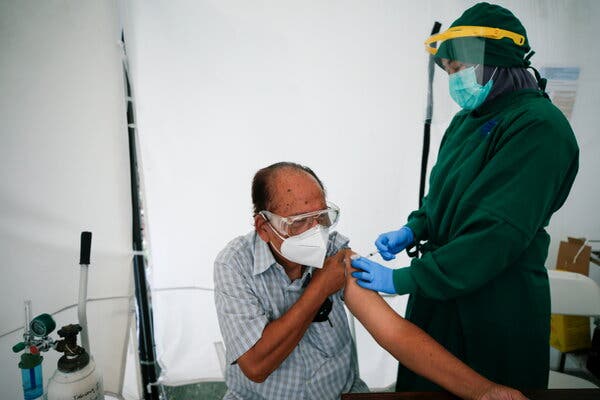
Indonesia began inoculating people 60 and older on Monday after health officials concluded that the Chinese-made coronavirus vaccine they were using was safe for that age group.
The government had been criticized over its earlier decision to exclude people 60 and older in the early stages of its vaccination campaign, which began on Jan. 13. People in that age group have accounted for half of Indonesia’s coronavirus deaths.
Officials said that clinical trials in Indonesia for the Sinovac vaccine, which is made by a private Chinese company and is the only one approved for use in Indonesia so far, did not include any volunteers over age 60 and that more data was needed.
Indonesia’s Food and Drug Administration reversed course last week, granting emergency use authorization for the Sinovac vaccine among older people after analyzing trial results from China and Brazil.
However, people 60 and older will receive their second dose of the vaccine after four weeks rather than two like everyone else because a trial showed that it would give recipients in that age group greater protection, said the agency’s head, Penny Lukito. The health minister, Budi Gunadi Sadikin, said the priority would be to inoculate older health care workers because they were most at risk.
Indonesia, the world’s fourth most-populous nation, with 270 million people, has recorded more than 1.1 million infections and more than 31,000 deaths, making it the worst outbreak in Southeast Asia. Experts estimate that the actual number of infections is at least three times higher than officially reported.
In other global developments:
-
China on Monday reported zero locally transmitted coronavirus cases for the first time since mid-December. In recent weeks, the country has been battling new outbreaks in northern provinces that prompted the government to impose lockdowns on millions of people. Though the National Health Commission reported one local asymptomatic case, such cases are not included in China’s official count.
-
The armies of Pakistan and Cambodia have both received donations of Covid-19 vaccines from the People’s Liberation Army of China, Chinese state news media reported, the first foreign militaries to do so. According to Xinhua, the state-run news agency, China has also donated vaccines to Laos, which on Monday received a shipment of the vaccine made by the state-owned company Sinopharm. Pakistan has reported more than half a million cases; while Cambodia and Laos have reported a relative handful, experts say the real number of infections is likely to be much higher.
-
The health minister of France, Olivier Véran, received a first dose of the AstraZeneca-Oxford vaccine on live television on Monday, as the country tried to pick up the pace of its vaccination rollout. Almost 2.1 million people in France have received at least one dose of a vaccine, but the country’s per capita vaccination rate is one of the lowest in Europe, according to a New York Times database. Asked about South Africa’s decision to halt the use of the AstraZeneca vaccine after trials showed that it fared poorly against a more contagious variant of the virus, Mr. Véran said the variant was hardly present in France.
-
The Australian Open began in Melbourne on Monday, after a three-week delay because of the pandemic. The number of spectators has been capped at 30,000 per day, or about half the usual attendance.
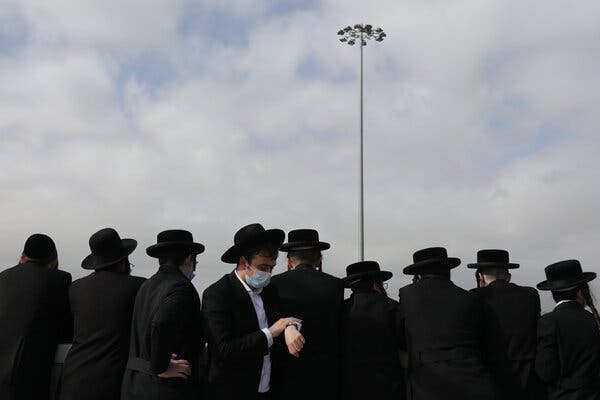
As the virus has rampaged through Israel in recent months, it has shaken the assumptions of some in the insular ultra-Orthodox world, swelling the numbers of those who decide they want out.
Organizations that help ultra-Orthodox who have left the fold navigate their transition from the highly structured, rules-based lifestyle into modern Israeli society have noted a rise in demand for their services.
Experts attribute the departures to a breakdown of supervision and routine, a rise in internet use during the pandemic and generally more time for questioning and self-discovery.
For many, breaking away means being cut off by their families and leaving a tight-knit support system for an unfamiliar culture. In extreme cases, parents of offspring who leave sit shiva, observing the traditional mourning rituals as if they were dead.
These exits were just what the ultra-Orthodox rabbis had feared and why some were so insistent on keeping their religious education institutions open in violation of lockdown regulations. In a letter calling for girls’ schools to reopen, Leah Kolodetzki, the daughter of one leading rabbi, said that in her father’s opinion “boredom leads to sin” and puts girls in “severe spiritual danger.”
Israel Cohen, a prominent ultra-Orthodox political commentator, played down concerns about the increasing flight from the ultra-Orthodox, known as Haredi in Hebrew. But he acknowledged that the Haredi leadership was afraid of losing control.
“There was a sense that the coronavirus caused not only physical harm, in terms of sickness and death, but also spiritual harm,” he said.
The pandemic has only accelerated a growing trend.
Even before the coronavirus crisis, the number of young adults leaving ultra-Orthodox communities had reached about 3,000 a year, according to a study by the Israel Democracy Institute, based on data up to 2018.
The desertions do not threaten the Haredi demographic clout. The more than one million Haredim account for over 12 percent of the population, and their high birthrate more than makes up for the numbers who are leaving.
Studies show that many leavers do not abandon Judaism altogether but are seeking more individualism and the ability to make their own choices about their lives.
But deserters often find themselves in a netherworld, estranged from their families, community and the only way of life they knew and, lacking a secular education, ill equipped to deal with the outside world.
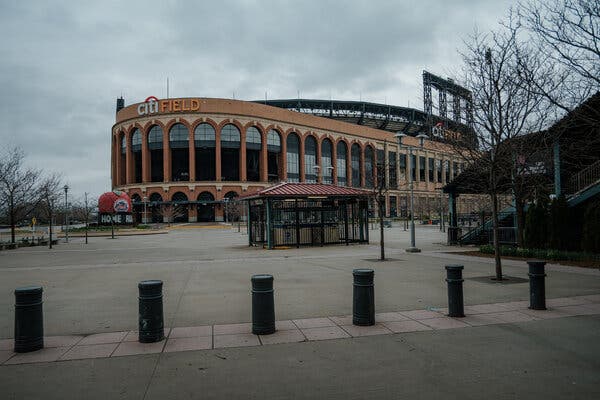
New York City will open a previously delayed vaccination site at Citi Field on Wednesday, Mayor Bill de Blasio announced on Monday. The site will focus on inoculating residents of Queens, which was hit particularly hard during the first wave of the pandemic, as well as food delivery workers and licensed taxi and for-hire drivers.
“This is going to be great for the people of Queens,” Mr. de Blasio said at a news conference.
The vaccination site will operate 24 hours a day, from Wednesday to Saturday, Mr. de Blasio said. Half of the appointments will be set aside for Queens residents who are eligible for the vaccine under state guidelines, which currently include health care workers, people older than 65 and some essential workers.
The other half will be reserved for drivers licensed by the city’s Taxi and Limousine Commission and food delivery workers from any of the city’s boroughs. The latter group became eligible for the vaccine last week, when Gov. Andrew M. Cuomo loosened eligibility criteria.
The vaccination program at Citi Field, home of the Mets, follows the opening last week of a similar site at Yankee Stadium in the Bronx, which currently has the city’s highest positive test rates.
The Yankee Stadium location, however, vaccinates only Bronx residents. Mr. de Blasio said that Citi Field’s large parking capacity led officials to determine they could better serve drivers and delivery workers, many of whom have been working throughout the pandemic at risk of contracting the virus.
So far, 997,844 doses of vaccine have been administered in the city, Mr. de Blasio said.



